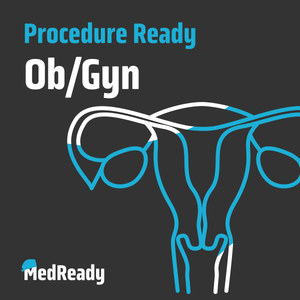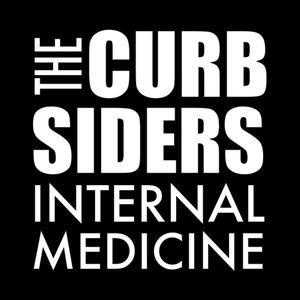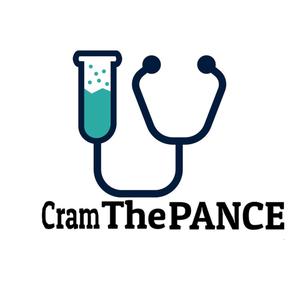
Procedure Ready: Ob/Gyn (fka Pimped Ob/Gyn)
MedReady
Procedure Ready: Ob/Gyn (formerly called Pimped Ob/Gyn) is a podcast aimed at medical, PA, and NP students who are entering their clinical rotation in Ob/Gyn. It covers topics including Your Ob/Gyn Survival Guide-Tips and Tricks, Labor and Delivery, Vaginal deliveries, C-sections, Hysterectomies, and more. Each podcast walks you through a portion of what you’ll experience during your clinical rotations, gives you tips for excelling, preps you for the clinical questioning that’ll occur, and sets you up to overall Honor the rotation! Email [email protected] with comments, questions, and episode ideas. ##Legal Disclaimer## The opinions expressed within this content are solely the speakers' and do not reflect the opinions and beliefs of their employers or affiliates.
- 13 minutes 36 secondsOperative Vaginal Deliveries
Incidence:
3.3% as of 2013
Indications:
- Prolonged second stage
- Risk of fetal compromise
- Shortening 2nd stage for maternal benefit (ex: cardiac conditions)
Consent:
- Comparison is c-section typically
- Failure rate of OVD is ~3-6%
- Forceps has higher success rate over vacuum, but also higher risk 3rd/4th degree tear
- Risks to both mom and baby
Prep:
- Fetus appropriate station/position
- Anesthesia
- Empty bladder
- Assess Pelvis/Passenger sizes/fit
- OR Ready
- Peds available
Episiotomy – NO!
Contraindications
- Fetal conditions, known or supspected: bone disorders (OI), bleeding disorders
- Maternal infections: Hep C, HIV, etc
- Concern for shoulder dystocia/cephalo-pelvic dysproportion
9 June 2023, 6:11 pm - 17 minutes 53 secondsInduction of Labor
Indications:
- Post-dates (42+wks)
- Late Term (41+ wks)
- Elective 39+wks
- Diabetes
- Hypertension
- Many more - check out ACOG Medically indicated delivery
39week induction
ARRIVE Trial - Multicenter RCT showing benefit to 39wk IOL over expectant management to ~41wks
Included
- Primips
- No medical indications for IOL prior to 40+5
Results
- IOL group had LOWER c-section rate than expectant group
- Neonatal composite outcome had a trend (not statistically significant) toward lower neonatal compilations in IOL group
Conclusion
- IOL at 39wks is as safe as expectant management without increased risks
- Many pregnant people are now offered a 39wk IOL rather than waiting for spontaneous labor
The IOL Process:
Evaluate and Prep:
- Full H&P
- Ultrasound for position - Vertex
- VE for cervical exam: dilation/effacement/Station, also position and consistency
- Calculate Bishops Score → help determine mode of IOL
Options for IOL: if biship score <8 for prime or <6 for multip, ripen first!
- Mechanical cervical ripening (balloon)
- Chemical cervical ripening (misoprostol or cervidil)
- Best yet--both!
Contractions (pitocin)
- Prime: Pitocin alone if Biship 8 or higher
- Mulitp: Pitocin alone if bishop 6 or higher
Augmentation: AROM
Failed IOL
- Failure to reach active labor after 18+hrs ruptured on pitocin (definition varies 12-24hrs ruptured on pitocin)
- If reaches active labor (6+cm), no longer failed IOL, now arrest of dilation or descent
9 June 2023, 6:10 pm - 16 minutes 53 secondsShoulder dystocia
Definition: Failure to deliver fetal shoulders with normal downward traction
Why we care: Baby hypoxia, brachial plexus injuries, maternal injuries
Risk factors:
- DM, excessive weight gain in pregnancy, S>D, Large baby
- Hx of shoulder dystocia (~10-15% recurrence)
- Turtling while pushing
Prevention
- No real prevention as SD is very hard to predict
- Offer cesarean delivery if EFW is >5000g and no DM, or >4500g and any type of DM
What do to:
- Step back. If comfortable, can help minimize family interference. Calmly explain what is happening and what the docs are doing.
- Offer to be the Timekeeper. Write down times and what is happening. Announce every 2 minutes.
What you’ll see:
- Prep: Hypothesize shoulder orientation for suprapubic pressure, place stool
- Announce problem- call for help
- Maneuvers - McRobers, suprapubic
- Posterior arm
- Rotational: Wood’s screw, Rubin
- Gaskins- all 4s
- Episiotomy
- Zavanelli
8 June 2023, 4:10 pm - 12 minutes 3 secondsCancer Screening and Vaccinations (HCM)
Cancer Screening
- Cervical: Age 21-65 Cytology q3yrs, co-test q5 if normal.
- ASCCP guidelines (there is an app! Or PDF: http://www.asccp.org/Assets/51b17a58-7af9-4667-879a-3ff48472d6dc/635912165077730000/asccp-management-guidelines-august-2014-pdf )
- Breast: ACOG: 40-75 annual mammogram
- Colon: Colonoscopy, FOBT, FIT. Begin at age 50. If first degree relative with colon cancer begin screening at age 40 or 10yrs prior to youngest diagnosis, whichever is younger.
- Lung: 55-80 with 30pack-year hx, annual low-dose CT
Vaccinations
- HPV: 3 dose series age 12-26
- Influenza: annual
- Pneumovax: 1 dose and 1 booster any age if risk factors. After age 65 if no risk factors
- Shingles: 2 dose age 50+
- Hep B: initial vaccination in youth, vaccination for anyone non-immune
- MMR: if not immune
- Varicella: if not immune
- Tdap: Booster at 10yrs, new parents
15 August 2018, 2:12 pm - 19 minutes 14 secondsSTIs
Swab/Urine
- Chlamydia: usually asymptomatic. Screen routinely. Can cause infertility/PID and Fitz-hugh-curtis. Treat with Azithro x1
- Gonorrhea: often asymptomatic. Screen routinely. Can cause infertility/PID. Treat with Ceftriaxone and Azithromycin
- Trich: frothy/watery discharge. “Strawberry cervix” Can see trich moving on wet mount. Treat Flagyl 2g PO once.
- HPV: Cervical dysplasia/cancer and Genital warts. Topical treatments as needed.
Serum
- Syphilis: Painless chancre followed by latent, then secondary with palmar/plantar rash. If unsure stage, treat as if latent, PCN IM x3
- HIV: Universal screening. PREP if high risk. Referral to ID and counseling if positive.
- Hep B: Treatable, not curable. Routine serum screening.
No Routine Screening, diagnose if lesion
- HSV: Antivirals as needed for outbreaks, can prophylax if frequent outbreaks/immunosuppressed. Valacyclovir or acyclovir are most common.
15 August 2018, 1:40 pm - 15 minutes 5 secondsBefore Your First: Colposcopy and LEEP
Why: ASCCP guidelines (there is an app! Or PDF)
Cervical dysplasia — caused by HPV
CIN I–CIN3 is a progression
Risk factors: Smoking, other STIs including HIV, immunodeficiency
Histology: Increased Nuclear: cytoplasmic ratio when abnormal
Acetic Acid: exact mechanism unknown, the higher N:C ratio cells (aka abnormal cells) reflect more light and appear white.
Lugols: Iodine rich-reacts with glycogen in normal squamous cells so they appear dark. Non-staining cells are abnormal.
HPV — changes
Colpo:
Increased vascularity, punctations, mosaicism, surface contour changes
LEEP:
Stain abnormality and know where abnormal biopsy was taken
Single pass is ideal–tag a side for orientation
+/- Top Hat depending on ECC result
CKC:
Higher up in cervical canal, but more complications
No electricity– okay if pregnant
13 February 2018, 5:50 pm - 12 minutes 30 secondsReturn OB Visits
Every visit:
- Doptones, fundal height, vitals
- Four question: Vaginal bleeding, contractions, leaking fluid, fetal movement
By Weeks:
- 20wks – get and review anatomy US
- 24wks – order glucola, cbc (check for anemia), discuss normal growing pains
- 28wks – Tdap and Rhogam if needed, discuss kick counts
- 32wks – Discuss BCM, sign tubal papers if needed, discuss TOLAC if needed
- 36wks – GBS screening, birth expectations, US for position
- 38-40wks – VE, “sweep membranes”
11 February 2018, 2:09 pm - 17 minutes 38 secondsFirst Prenatal Visit
- Planned/Desired
- Options counseling if needed
- Exam/pelvic/pap
- Ultrasound for dating
- Screening options: QUAD, Sequential, NIPS, invasive testing
- Pregnancy guidelines
- Weight:
- BMI under 18.5 should gain 28–40 pounds.
- Normal-weight women (BMI, 18.5–24.9) should aim for 25–35
- Overweight women (BMI, 25–29.9) should aim for 15–25
- Obese women (BMI, 30 or more) should gain only 11–20
- Food: Avoid unpasteurized dairy, large fish (swordfish, shark, king mackerel, tilefish, bigeye tuna etc), uncooked meat/seafood, uncooked deli meat, EtOH
- Drugs: Nothing unless cleared by MD. Tylenol okay if needed, PNV, Colace, FeSO4. NO NSAIDs!
- Exercise: Nothing that could leave a bruise on your belly! Moderate exercise is great.
8 February 2018, 9:09 am - 10 minutes 15 secondsBefore Your First: Hysteroscopy
Hysteroscopy = looking inside the uterus with a scope
Steps:
- Dilate the cervix
- Distend the uterus with fluid
- Look around, identify pathology, identify tubal ostia, remove pathology if using an operative scope or Myosure or another resectoscope.
Feared complication: Hyponatremia from excessive hypotonic fluid absorption.
10 January 2018, 6:04 am - 21 minutes 25 secondsPeripartum Fevers
Intrapartum
Differential diagnosis for Temp >38.0C
- Epidural fever (transient), DVT/PE (if prolonged IOL or limited mobility), UTI, Intraamniotic infection (with or without ROM), etc
Chorioamnionitis aka IAI aka Triple-I (intrapartum intraamniotic Infection)
- One temp >39.0C
- One temp 38.0C-39.0C AND one or more risk factors
- Two temps >38.0C 30+ mins apart
Tx: the standard is Ampicillin/Gentamycin until delivery. Tylenol prn temp>38C, IVF for maternal/fetal tachycardia, cooling blanket if needed to decrease temp.
If mild PCN allergy: Ancef/Gent
If severe PCN allergy: gent/clinda or gent/vanc
If vaginal delivery: No evidence that continued abx postpartum provide benefit.
If c-section: Add clindamycin to Amp/Gent.
Continue at least 1 dose postpartum. Clinical judgment on when to d/c. Some do 1 dose, some 24hrs afebrile, until clinical improvement, etc.
Postpartum
Wind – PNA, atelectasis, URI
Womb – Endomyometritis — Gent/Clinda x 24hrs afebrile
Wound – Superficial wound infection, cellulitis — eval for collection, probe wound/fascia if able
Water – UTI, Pyelo — get UA
Walking – DVT/PE
Weening – Engorgement or mastitis
Wonder drugs
7 January 2018, 8:57 pm - 24 minutes 44 secondsPostpartum Hemorrhage
Causes (Four T’s):
- Tone: Atony
- Pitocin
- Misoprostol: CI-allergy, SI-transient hyperthermia
- Methergine: CI-HTN, SE-HTN
- Hemabate: CI-asthma. SE-diarrhea
- Tamponade: bakri/utah balloons
- Trauma: Lacerations
- Tissue: Retained POC (placenta or membranes)
- Thrombin: Coagulopathy
- Other: Involution
13 December 2017, 9:14 pm - Tone: Atony
- More Episodes? Get the App
Your feedback is valuable to us. Should you encounter any bugs, glitches, lack of functionality or other problems, please email us on [email protected] or join Moon.FM Telegram Group where you can talk directly to the dev team who are happy to answer any queries.
 EM Clerkship
EM Clerkship
 The Curbsiders Internal Medicine Podcast
The Curbsiders Internal Medicine Podcast
 Dr. Chapa’s Clinical Pearls.
Dr. Chapa’s Clinical Pearls.
 CREOGs Over Coffee
CREOGs Over Coffee
 » Divine Intervention Podcasts
» Divine Intervention Podcasts
 Cram The Pance
Cram The Pance